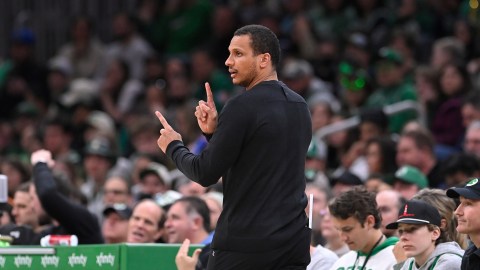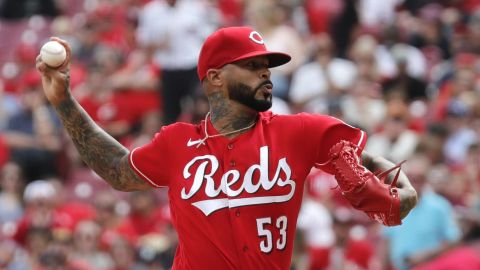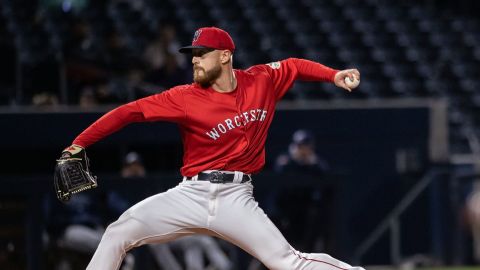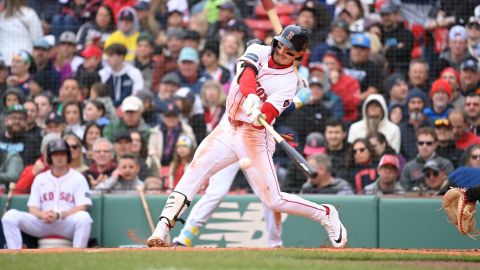Curtis Granderson is now wearing pinstripes. Outfielder Austin Jackson, reliever Phil Coke and minor league starter Ian Kennedy no longer are. But according to WEEI.com’s Rob Bradford, things could have gone very differently on Tuesday afternoon at the winter meetings.
Before Tigers GM Dave Dombrowski approved the three-way deal that also sent right-hander Edwin Jackson to the Diamondbacks, he reportedly gave the Red Sox an opportunity to bring the 28-year-old Granderson to Boston, and keep him away from the Bronx. Theo Epstein balked, so Dombrowski went ahead with the aforementioned blockbuster.
But should Boston have been so reluctant to meet the Tigers’ asking price — Jacoby Ellsbury or Clay Buchholz — for Granderson, who hit 30 homers and stole 20 bases last season?
Considering that homegrown pitching is perhaps the most valuable commodity in baseball, dealing a rapidly maturing Buchholz for Granderson would have been unwise. Buchholz went 4-1 with a stellar 2.87 ERA and 1.09 WHIP in his last six starts of the past regular season, and the Red Sox are counting on the 25-year-old to blossom into a quality No. 3 starter for them next year. Moreover, Buchholz still has the potential to develop into an ace, if he learns to properly harness his excellent arsenal of pitches. Epstein was wise to keep him.
However, that still left the possibility of directly swapping center fielders with Detroit.
Ellsbury, 26, has become a fan favorite in Boston, thanks to his blazing speed and web gems in center field. He hit .301/.355/.415 for the Red Sox last year, and stole 70 bases while being caught just 12 times. Ellsbury is also under team control for four more seasons, and though his annual salaries will increase once he becomes eligible for arbitration next winter, he will remain a relative bargain to the Red Sox in the foreseeable future.
But while Ellsbury continues to grow into one of the best leadoff hitters in baseball, it’s important to acknowledge that he has limitations. Now approaching his peak years as a player, the 26-year-old Ellsbury is unlikely to develop Grady Sizemore-like power, and he may struggle to reach double-digits in homers for the majority of his career. Ellsbury also is not the second coming of Johnny Damon — Ellsbury is faster and more aggressive in the batter’s box, while Damon possesses more power and discipline at the plate.
Additionally, Red Sox Nation may be overrating Ellsbury’s glovework in center. He is an incredible athlete, and his speed and leaping ability should make him a perennial Gold Glove contender. But Ellsbury is not yet adept at reading the ball off the bat and taking the most direct route to its eventual landing spot. His wheels and dives make up for those shortcomings, but still leave him far short of being an elite defensive outfielder.
In fact, according to the plus-minus defensive metric developed by John Dewan, Ellsbury made 14 fewer plays than he should have last season, based on the performance of the average center fielder. The system also indicates that Ellsbury’s defense resulted in eight additional runs for Boston’s opponents, ranking him second-to-last in that category among qualifying center fielders.
To be fair, Granderson has significant shortcomings to address as well.
Granderson bashed 61 extra-base hits last season, but his .780 OPS was just 10 points higher than Ellsbury’s. The left-handed hitting Granderson’s production also came almost entirely against right-handed pitchers, leaving him with a worrisome platoon split: .275/.358/.539 with 55 extra-base hits in 451 at-bats against northpaws, compared to just .183/.245/.239 with six extra-base hits in 180 at-bats versus southpaws. The Red Sox could certainly have found a viable platoon partner for Granderson — Rocco Baldelli would fit the bill well — but that would have required committing two players’ salaries to a single position.
Defensively, Granderson owns a sizeable advantage over Ellsbury. He was credited with 17 more plays than the average last season, and saved 10 runs with his fielding. According to The Fielding Bible, Granderson was the third-best center fielder in baseball last season.
Then again, Grandy — who is signed under reasonable terms through the 2012 season with an option for 2013 — also would have cost far more than Ellsbury, according to Cot’s Contracts. He is set to earn $5.5 million in 2010, $8.25 million in 2011 and $10 million in 2012. The 2013 option is worth $13 million with a $3 million buyout. That amounts to $23.75 million over the next three seasons, and the Red Sox will pay Ellsbury only a fraction of that.
All things considered, FanGraphs rates Ellsbury as a 1.9 win player during the 2009 season while assessing Granderson’s value at 3.4 wins.
Assuming nothing changes during the next three years, the difference between the production offered by Ellsbury and Granderson over that span should be roughly 4.5 wins. Meanwhile — based on a rough estimation of Ellsbury’s early arbitration figures — the difference in their salaries will amount to about $10 million to $12 million.
Is the gap between them worth the additional money required to bridge it? Probably not, especially when Ellsbury’s continued improvement is factored in.
Hence, even though Epstein’s decision to stand pat enabled the Yankees to acquire another impact player, it was the right call.



